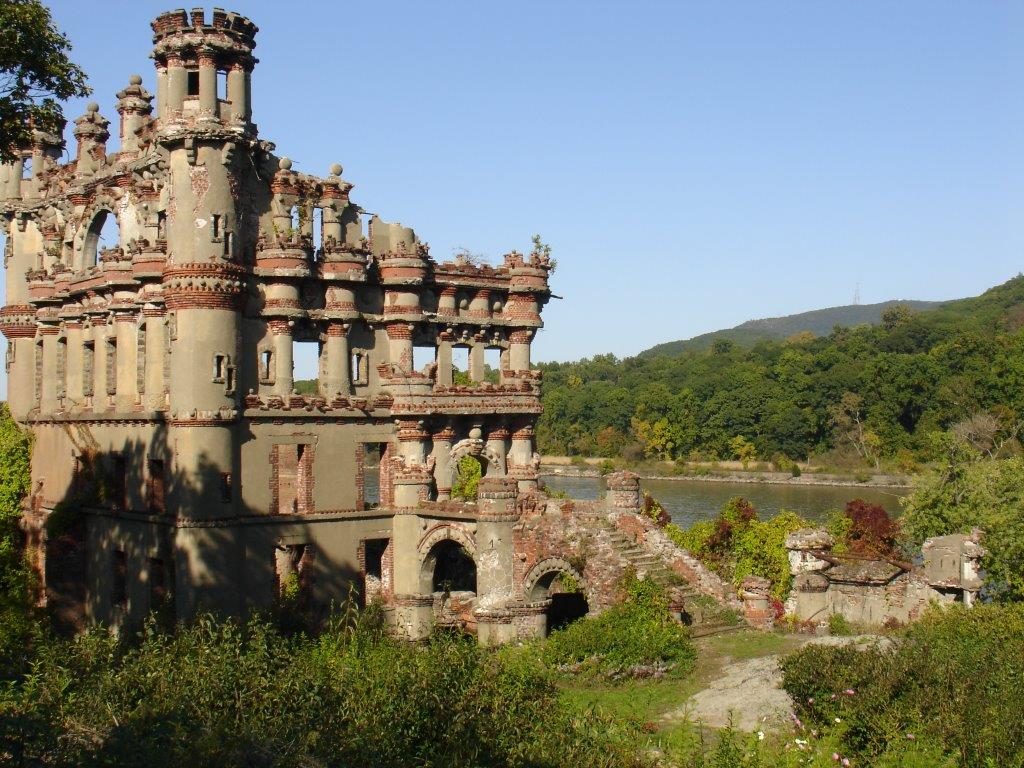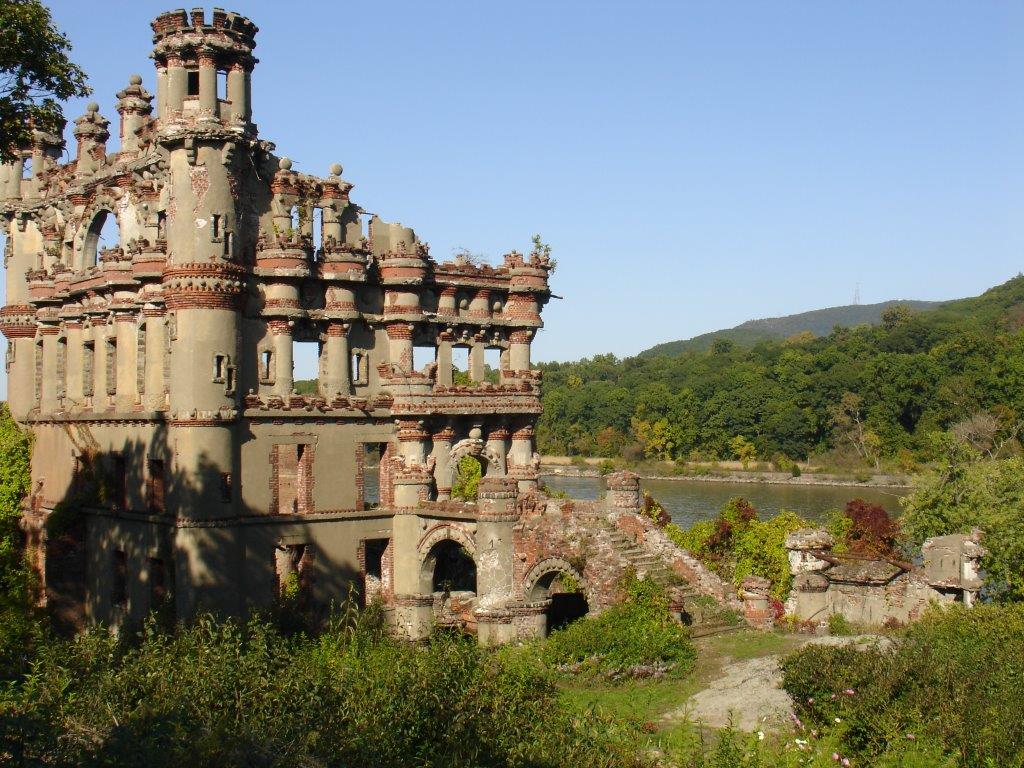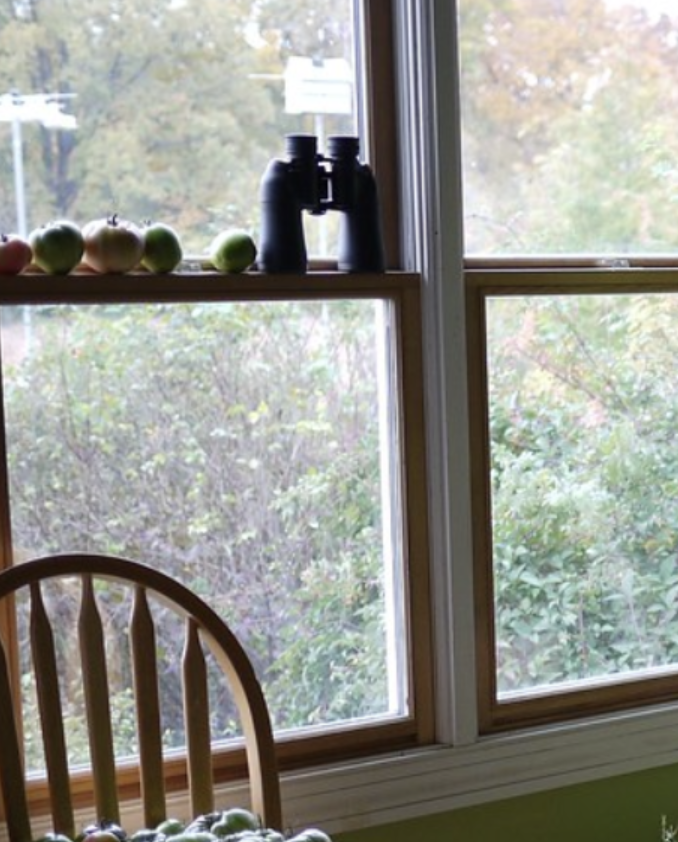
There is something in me that loves an island. I live on one (Queens, New York, on Long Island, across the East River from the isle of Manhattan). I’m attracted to all kinds—those buried by volcanic eruptions; adrift in a blue void endless as the cosmos; locus of nearly extinct languages; and even the fictitious Island of Lost Souls ruled by the mad scientist Dr. Moreau.
But one island I recently discovered has fascinated me like no others—Bannerman Island in the Hudson River, home to the crumbling ruins of a faux Scottish castle built 100 years ago to hold an arsenal of artillery, left-over ordnance from battles the world over. It is a place with no right angles, designed on the backs of envelopes—the fantasy-vision of eccentric international businessman Francis (“Frank”) Bannerman.
Emigrating from Scotland with his family as a child, Bannerman went on to transform his father’s modest military surplus business in Brooklyn into the world’s largest supplier of military goods, including guns and other weapons. A block-long store in lower Manhattan described as a museum by patrons housed the acquisitions. Bannerman’s Catalogue of Military Goods, produced annually, was considered the ultimate reference-and-purchase guide for collectors. My brother, a CPA born with the soul of General Patton, remembers the hours he used to spend pouring over its pages as a teenager.
Tons of stored cartridges and densely populated, turn-of-the-century Brooklyn make uneasy neighbors, though. Pressured by officials to relocate his volatile inventory, Bannerman bought the 6.5-acre, then-named Pollepel Island in 1900. Soon he began constructing a castle to house his stock 50 miles north of the city.
Pulling up to the island on a small tour boat one spring day, I had a pervasive sense of gloom despite the sunshine. “Bannerman’s Island Arsenal,” carved into the crumbling castle façade, seemed like a demented ghost’s looming billboard for himself. I glimpsed towers and crenellation, an illegible ancestral escutcheon, and sky through what had once been windows. Chunks of cement had decomposed, revealing badly damaged brick. In one spot, a flight of steps led to blue emptiness. Amid these gutted ruins were flashes of flamboyance in the form of swirling, carved decorations and heraldic mottoes, the chiseled words now a mystery.
On a higher spot of the island Bannerman built a smaller castle as a summer residence for his family. But the arsenal had pride of place. Perhaps that’s only fitting, for it was war that made Bannerman a Gilded Age powerhouse. And it was war that played a role in the history of Pollepel Island as well: during the Revolution, patriots strung iron-tipped logs from the island to the shore in an unsuccessful attempt to obstruct the passage of British ships.
The Brooklyn officials’ fears were justified—inevitably 200 tons of black gunpowder exploded, severely damaging part of the complex in 1920 before construction had even been completed. A fire in 1969 finished off the arsenal’s roof and floors.
War and arms-dealing made a genius businessman’s fortune possible, and violence clings to the island like permanent fog. Perhaps the ground is cursed. As far back as the 1600s, the Dutch whispered tales of eerie happenings. I wasn’t surprised to learn that I’m not the only writer drawn by the insidious magnetism of the island—the setting of a murder in the mystery Killer Heart, the site of a villain’s experiments on humans in a DC comic series, and the training ground of blood-suckers in The Vampire Journals.
As I was making notes for this dispatch, I was startled to read the headlined story of a young engaged couple who went kayaking in separate boats on the Hudson River. The man’s kayak capsized, and his fiancé tearfully reported his drowning. Said to be a volunteer gardener on Bannerman Island, she somberly placed flowers there in his memory. After all, Bannerman Island was the site from which the couple cast off into the Hudson’s treacherous waters on the evening of April 19. Ten days later, the young lady was arrested for murder.
I ask myself, what is it about this particular island that holds such unsettling, even Gothic appeal for me? Although a historic trust opened the grounds to small guided tours a few years ago, the place groans with its past. It festers unseen as we climb up the rough, steep trails and down paths designed by Bannerman himself in order to get a closer look at the buildings. Below the rocky ground lay shards of Civil War bayonets, Boer War sabers, and Spanish American War cannon balls, mingling with toys, teapots, and scraps of singed Irish linen. Remnants of war, remnants of Bannerman family domestic life once scattered by the explosion are now buried together by time and the elements.
Maria Terrone’s work has been published in such magazines as Poetry, Poetry International, The Hudson Review, the Notre Dame Review, and in more than 20 anthologies.
Photo by Bill Terrone.




